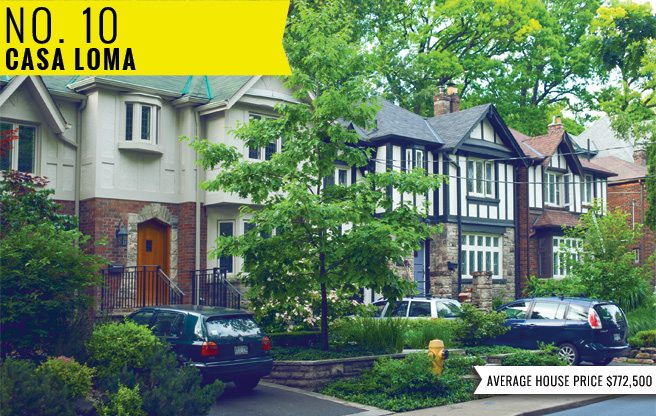The latest news from Toronto's incredible real estate industry. Learn about Toronto Condos, Toronto Homes and more.
Wednesday, November 27, 2013
Rising prices, mortgages making real estate unaffordable for many: RBC
OTTAWA—Higher prices and an increase in mortgage rates have made home affordability more of a problem for the average Canadian family, says a new reportfrom the Royal Bank of Canada (TSX:RY).
RBC’s latest research on the portion of average household income needed to maintain a home shows that affordability deteriorated over the summer, the second consecutive drop in as many quarters.The level of deterioration differs from region to region and between types of homes, but for the average bungalow the affordability measure rose 0.7 of a percentage point to 43.3 per cent nationally in the third quarter, after a 0.3-percentage-point gain in the second quarter.
Thursday, September 5, 2013
Why Real Estate Doomsayers Continue to be Wrong!
Canadians’ homes are getting less affordable, but we still keep buying
This article appears in the September edition of the Financial Post Magazine.
Mandy Coz needs a lead. She isn’t the first sales rep from a nearby real estate brokerage to cold call my parents’ home in the suburbs on behalf of a family that badly wants to become our neighbours. But she’s the most recent and she’s on the hunt for a new seller. Her clients “lost out” on another property on our street.
Wednesday, September 4, 2013
No. 6 Wexford-Maryvale
From: Toronto Life
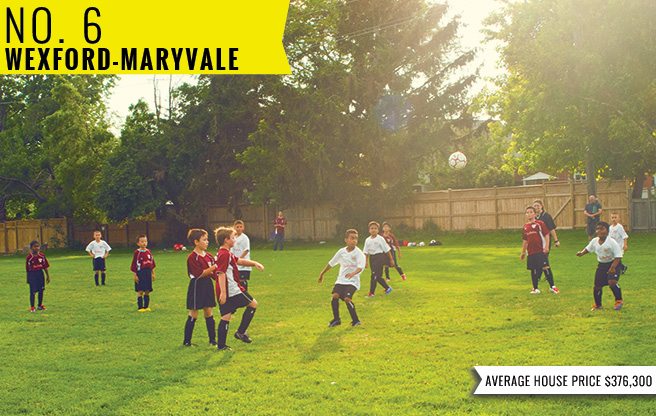
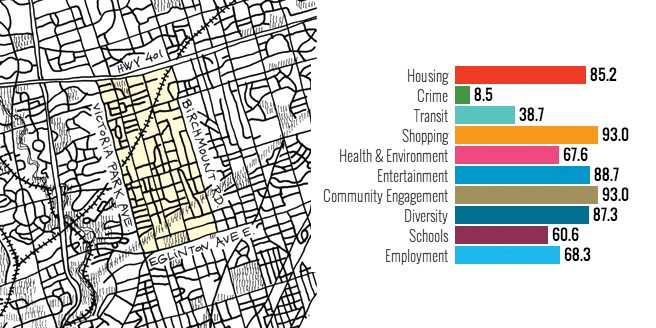

At Al Premium, the gleaming new 75,000- square-foot grocery store at Eglinton and Warden, bags of Filipino jute leaves share the aisles with sacks of Vietnamese glutinous rice flour, Caribbean spices and Halal meats. The cafeteria counter transitions seamlessly from shawarma to mutter paneer to pho to dim sum, and the bubble tea station, staffed by a teenager in a hijab, abuts the espresso machine. The store caters to the mind-boggling diversity of the westernmost bit of Scarborough, which fulfills Toronto’s promise as a multicultural city in a way that no downtown neighbourhood has in decades—nearly half of the residents here are visible minorities. The diversity is vividly realized at the annual three-day Taste of Lawrence festival, for which the local BIA manages to close off a six-lane suburban arterial to traffic (downtowners would be surprised at how many people opt to walk).

In contrast to the hectic excitement of the main streets, all is placid on the inner residential lanes, where pretty post-war bungalows on perfectly kempt lots go for less than $500,000. There are even a few reminders of the mid-1850s village that used to stand here, like the old Anglican Church of St. Jude in Wexford and a copse of gnarled, hundred-year-old oaks and sugar maples that somehow survived clear-cutting at the top of Wexford Park. Further north on Pharmacy Avenue is Wexford Collegiate School for the Arts, the east end’s magnet for budding singers, actors and artists, whose alumni include sculptor Shary Boyle, Canada’s representative at this year’s Venice Biennale; and Degrassi’s Nina Dobrev—and yes, the school’s “Gleeks” recently sang an earth-to-orbit duet with Chris Hadfield.
Tuesday, September 3, 2013
#7. Mount Pleasant East
From Toronto Life
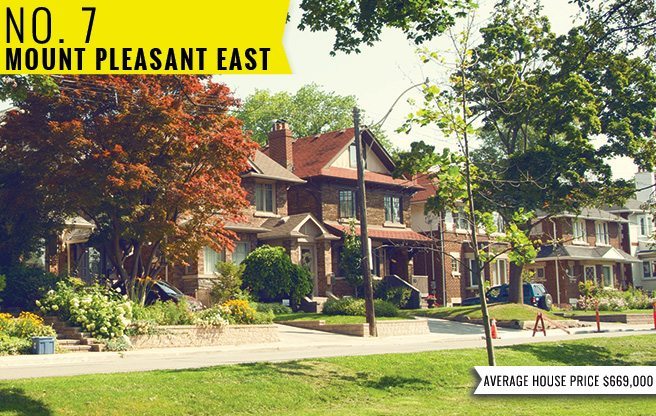
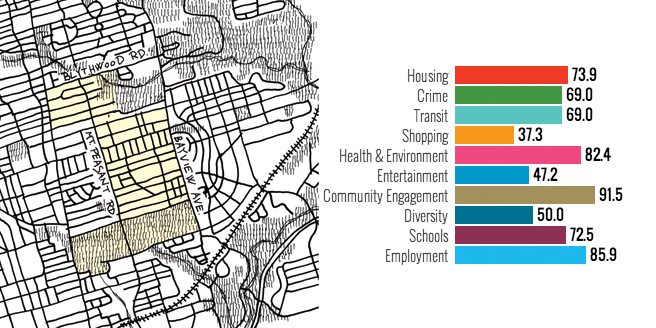

The snaking paths that connect the remains of the great and good in Mount Pleasant Cemetery are also some of the city’s most picturesque running routes, passing by fountains, gardens and hundreds of rare trees from around the world. It’s because of those trees that the midtown neighbourhood in which the cemetery sits has the city’s densest, plushest canopy. Unlike renter-dominated Mount Pleasant West next door, Mount Pleasant East feels like a small town full of professionals drawn by the quiet, leafy streets and central location. Housing stock here is a mix of brick semis and detached homes from the 1920s, with the occasional mansion and modern glass and brick stunner thrown in. One of the most attractive streets is Belsize Drive, which is split in two by a linear park, beloved by dog walkers, called Glebe Manor.

Homes don’t often come on the market, and when they do, bidding wars are the norm: one old semi recently went for $760,000—$80,000 over asking—after 200 visitors and seven bids. Of the two retail strips that flank the neighbourhood, Davisville Village, on the west side, is more interesting and varied than Bayview. Up the street is Mabel’s Fables, one of the city’s best children’s bookstores. The strip is also home to a 125-year-old camera club; two of the last small-time neighbourhood cinemas, the Regent and the Mount Pleasant; and three surprisingly good bistros, Célestin, Jules and Mogette, that fill up each weekend with families out for brunch.
Friday, August 23, 2013
#8 The Beaches!
From: Toronto Life

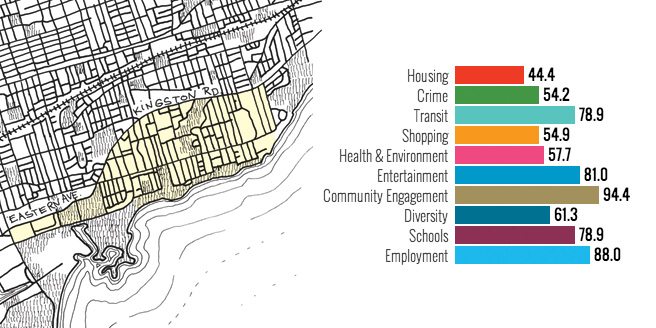

The Beach is the only segment of Toronto’s waterfront that lives up to its enormous potential as a place to live and play. That’s why the 3.5-kilometre boardwalk is invaded every weekend by pleasure-seekers and why a detached home on one of the picturesque streets by the water seldom goes for less than a million dollars. It’s also why the word “Beach” has been climbing steadily uphill from the lake, first transforming the gracious homes north of Kingston Road into the Upper Beach and then spawning Beach Hill just south of the train tracks, the latter’s dubious connection to sand and spit notwithstanding. Residents of the actual area tend to stay away from the crush of beach volleyball and kitesurfing at Ashbridge’s Bay Park, sticking to the quieter eastern stretches or relaxing over a pint at the Balmy Beach Club, a relic of the days when the shoreline was filled with amusement parks.

The styles of the houses here are more eclectic than in just about any other old Toronto neighbourhood. By the water, tiny Victorian summer cottages mingle with low-slung apartment buildings and larger houses from the ’20s and ’30s, some featuring kitschy lakeside resort details like porthole windows. In the 1990s, Greenwood Raceway was torn down and replaced with Woodbine Park, which gets taken over by a different festival every summer weekend (Ribfest, the Muhtadi International Drumming Festival, the jubilant Beaches International Jazz Festival). To the east, there’s a dense New Urbanist development laid out on six streets, bringing new waterfront housing to hundreds of families in the area for the first time in decades (even if the trees have yet to fully grow in). Beach residents are famously averse to new development, and the first modern mid-rise condos are only now appearing along the fiercely protected Queen East retail strip.
Thursday, August 22, 2013
#9 Mimico
From: Toronto Life
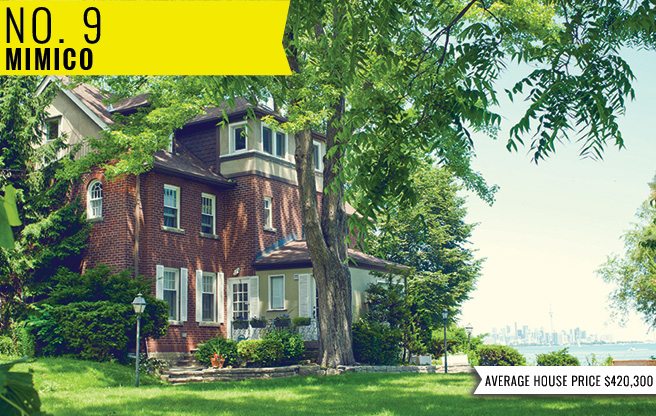
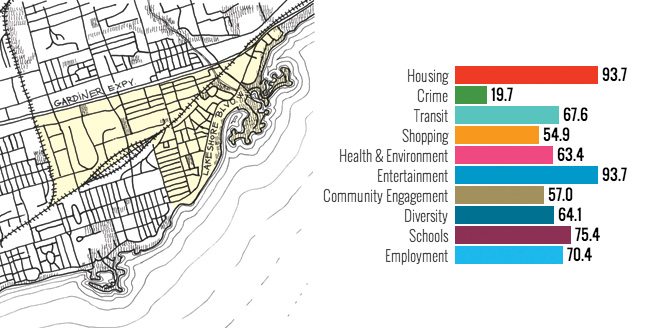

Ask Mimico residents about their neighbourhood, and they’ll get a starry, faraway look in their eyes as they rhapsodize about their little commuter village by the lake. It’s easy to get swept up by the small-town feel of neighbours looking out for each other’s kids, or by the tiny waterside parkettes at the end of the streets, some with chess tables. Or, for that matter, by the bucolic cottages and bungalows on generous plots that go for about the same as a condo downtown. Every weekend, cyclists take to the lakeside trails and dog walkers brush by joggers in Mimico Waterfront Park, a new kilometre-long green space with pockets of wetland habitats, and boardwalks along the shore that connect to the waterfront trail. The Humber Bay Shores area just to the east is quickly filling up with 38- to 66-storey towers whose meretricious names evoke Miami Beach—Ocean Club, Jade, Eau du Soleil—but Mimico itself has so far resisted that kind of intensification.

A revitalization plan recently approved by city council caps off new Mimico buildings at 25 storeys while sprouting parkland and increasing access to the lake (it also allows developers to replace the crumbling apartment blocks from the ’50s and ’60s). After years of planning, GO trains are now running every half hour to Union Station (it’s a mere 15-minute jaunt for Bay Street–bound commuters), and new businesses are slowly creeping in, like FBI Pizza, a delivery outfit run by Queen Margherita Pizza alumni. Whatever real estate agents might say, the area is a long way from becoming the western Beach. The pace is less harried here, there’s not nearly the density of cutesy restaurants and shops, and Starbucks has yet to invade. And that’s precisely how Mimico residents like it.
Tuesday, August 20, 2013
Toronto Neighbourhood Rankings
From Toronto Life
In a city with so many great pockets, and many more improving faster than you can say gentrification, the competition for the title of Number One Neighbourhood is cutthroat.Monday, August 19, 2013
In a hot Toronto market, should I price my house high or low?
Question: I'm planning to sell my house soon. From what I've seen in the news, the summer market was unexpectedly strong - should I be "aggressive" in pricing my home?
Answer: The summer market in Toronto was indeed unexpectedly strong – the number of resale homes and condos sold in July 2013 was up 16.4 per cent over the same period last year. Many experts are predicting this momentum will continue into the fall market despite steadily rising interest rates.
In terms of pricing your home “aggressively,” that could mean aggressively low or aggressively high. The decision to go with a higher list price versus a lower one (the latter is usually intended to create a bidding war) depends on several factors. One of the biggest, as is usually the case in real estate, is location.
Last fall, homes in high-demand areas like the Beaches, Riverdale, East York, High Park and Leaside had sale price to list price ratios of 100 to 102 per cent. That means they sold for asking or more than asking in the majority of cases.
In contrast, some areas located in the outskirts of the GTA like Durham, York and Peel had a slightly lower ratio for sale price to list price. That said, the percentages were only slightly lower, ranging from 95 to 98 per cent of asking. In real dollars, that could equate anywhere from a few to several thousand less than the list price, depending on the price point of the home.
When advising my clients about how to price their own homes, I always emphasize the importance of not overpricing. Overpricing your home can discourage prospective buyers from even visiting, limiting the exposure that you really need. The more people viewing your home the better!
If you are worried about underpricing and leaving money on the table… don’t worry. In my experience, the market itself always works in dictating fair market value. If you’re in a hot area, a fair and even lower than expected price may even drive a bidding war to your benefit.
It’s the basic principle of supply and demand. If supply is low in your area and demand is high, then it will drive the price up. The opposite holds true as well.
Much depends on timing, and you have to get granular with your timing strategy within your community. Weekly changes to available inventory will have a significant impact on your outcome in an active market.
For example, if there are three houses listed for sale on your street at the same time, you may want to wait and see what happens with them. If you list alongside them, you’ll be competing with all those homes, and odds are that will affect the value others put on your home – usually negatively unless you have a truly star property.
Conversely, if there are no homes listed on your street, but the last home that sold went over asking, it’s a good indication of pent-up demand in your area. With that demand and no or minimal competition, it’s the optimal time to list.
While there are no guarantees in real estate, diligent planning and research can give you an accurate picture of historic trends in your neighbourhood, and an edge in determining your own strategy.
One final piece of advice on pricing: Always take a big step back from the personal attachment you have to your home when determining price. It’s human nature to put more value on your home than may be realistic because of all of the work, money and memories you have vested in it. But prospective buyers and real estate professionals don’t see it that way – they’re looking at it with an objective frame of mind. Any subjectivity they factor in to the perceived value applies to their wants and needs, not yours.
When you’re pricing your home, think like a buyer. Be realistic, do your research and be ready to list at the right time.
As City of Toronto sells off its homes, buyers see $$$
The houses are the very definition of “as is.” Most are dilapidated and untidy – some are downright squalid.
And almost all of them have sold well above the asking price with a handful of bidders competing for the chance to rip up the tile floors and tear out the old bathtubs.
The properties are in the portion of the Toronto Community Housing Corp. portfolio designated for sale, two at a time. TCH plans to sell 68 vacant properties in 2013 and 2014.
Last week, for example, a rowhouse on Booth Street in Leslieville drew 11 offers. The house – listed at $499,000 – has crumbling plaster and a sagging porch, but it offers a coveted location, a private backyard and parking. The winning bid was about $580,000.
Most of the buyers are renovators and flippers who undertake a thorough overhaul, then resell the property, says real estate agent Leonard Fridman of ReMax Hallmark Realty Ltd., who has taken on the task of selling more than 40 of the houses.
Mr. Fridman and his team of agents are listing two properties each Monday, with an offer night scheduled to follow a flurry of open houses and appointments.
This week’s houses are in the east end, at 176 Eastwood Rd. and 93 Empire Ave. Potential buyers are expected to swarm through at the open houses this weekend.
“They tend to be in urban pockets that are gentrifying and continue to gentrify,” says Mr. Fridman of the houses in such neighbourhoods as the Beach, Riverdale and High Park.
Mr. Fridman, who specializes in buying and selling investment properties, has a large database of more than 2,000 potential buyers. He sends out an e-mail each week to let them know which houses are coming onto the block. He also lists them on the multiple listing service of the Toronto Real Estate Board.
TCH spokeswoman Sara Goldvine says Toronto’s social housing agency has all of the properties appraised to ensure that they are sold for fair market value or above. TCH is using the proceeds to offset a repair backlog on its remaining properties that stood at $750-million in 2012 but is expected to swell to $1-billion by 2015 without new sources of funding.
Ms. Goldvine confirms that the six deals that have closed so far in this batch – with approximately 10 more slated to close in the coming weeks – have produced bounteous selling prices.
“The sales are going better than expected,” Ms. Goldvine said.
Real estate agent Nicholas Bohr, who is working with Mr. Fridman on the sales, says the builders and renovators who are buying them like the fact that they’re not paying anything extra for embellishments.
“They tell us the more that’s wrong with the project the better because they have more opportunity to make money from it.”
Mr. Bohr, like everyone on the Fridman Elkind team at ReMax, is an investor himself.
Mr. Bohr says some potential buyers are young couples and other people looking to get into a single-family dwelling. In many cases they find the scope of the renovation just too daunting.
“They’ve been vacant for two to three years,” he says of the shabby condition of most of the houses. “That has taken its toll as well.”
But he thinks some buyers could end up with a desirable house in a sought-after area if they are willing to put in some time and effort.
“These are all great opportunities for a young couple to save some money on their first home,” he says. “But they get scared of the scope of what they’re getting themselves into.”
Toronto Condos - Toronto Lofts
"Shocking" number of luxury condos for sale on MLS
The number of $1 million-plus condos for sale in Toronto has reached such “shocking” levels, it would take about 20 months to sell them all given current demand, more than four times what it would take to clear the current inventory of more conventional condos.
What’s even more worrisome is those numbers don’t include “shadow inventory,” which could easily exceed the number of high-end condos that were listed for sale on the Multiple Listing Service as of the end of June, says Toronto realtor Andrew la Fleur who did the math recently on behalf of an investor.
That shadow inventory includes units that have yet to sell in five-star hotel projects like the Trump International Hotel & Tower, Ritz-Carlton, Shangri-La and Four Seasons, all of which have hit the market in the last two years.
Also part of that great unknown are pricey penthouses still sitting empty in dozens of newer condo projects, especially in the downtown core: Developers don’t like to dump too many of their unsold units on the publicly accessible MLS system all at once, for fear it can make the project look bad and undercut prices.
In the first six months of this year, there were 145 condos listed on MLS for $1 million or more, says la Fleur, who was shocked by the numbers when he started delving into the high-end market recently on behalf of an investor who wanted to know if they stood to make more money buying one pricey property or two or three cheaper condos.
Only 42 of those $1-million plus units actually sold, an average of seven per month, says la Fleur. That equates, in key real estate market terms, into a 20-month supply. It was even higher, 25 months, in tony Yorkville, much to la Fleur’s surprise.
That’s more than four times the three to five-month supply of more conventional condos that were for sale in the first six months of 2013.
“It’s very crowded out there,” says la Fleur, who found prices have remained flat, or even slumped, for folks who bought into many of the five-star hotel projects before they were built.
He believes it could be at least three years, and perhaps as much as a decade, before investors in that sector really start to see gains.
While prices have indeed been flat, there hasn’t been the slump many had expected now that all those five-star offerings are up and open, says Shaun Hildebrand, senior vice president of condo research firm Urbanation.
“When you look at the numbers and relate them to the rest of the market, it would suggest that there is a glut, a drastic oversupply,” of $1 million-plus condos, says Hildebrand. “But this is a very niche segment of the market. It really needs to be looked at in isolation.”
In fact, months of supply in Yorkville has always run about twice that of the conventional condo market and it’s just going to take time for all these new units to find buyers, he added.
“This is a new market to Toronto, it’s still in its infancy.”
Wealthy buyers are still looking at Toronto, says Ross McCredie, chief executive officer of luxury realtor Sotheby’s International who sold his $2 million condo in the Four Seasons last spring to a Hong Kong buyer.
“There are a lot of people actually purchasing higher-end condos with cash as investment vehicles that they can rent out because the vacancy rate is so low in Toronto,” says McCredie. “That’s a key indicator. It shows that on a long-term basis, those condos are going to prove out.”
In fact, dozens of condos in the Ritz, Shangri-La and Four Seasons are already being rented out, either by choice or because investors couldn’t find buyers. Rents are running more than $3 to more than $5 per square foot.
That translates into a mere $6,000 a month for a 1,600 square foot unit at the Ritz.
Toronto Condos - Toronto Lofts
Toronto, Hamilton lead real estate recovery
Canadian home resale prices increased in July, boosted by strong gains in Hamilton and Toronto.
According to the Teranet-National Bank Composite House Price Index, which is a weighted index of 11 cities across Canada, prices increased 1.9 per cent last month from a year earlier.
Toronto saw gains of 3.4 per cent, while Hamilton was up 6.7 per cent.
“Hamilton is an up market by any respect,” said National Bank senior economist Marc Pinsonneault. “The only weakness we see in Toronto is that there many unsold new condos, including those on pre-sale and under construction.
“That’s the only part of the Toronto market that you can say is weak,” he said.
On a monthly basis, the Teranet-National Bank House Price Index rose only 0.7 per cent in July, weaker than the average increase of 1 per cent seen over the last 12 years.
On a nation-wide basis, home prices have only increased by 1.9 per cent, in part because of a price correction that began in September 2012 and only ended a few months ago, Pinsonneault said.
Although home resale prices are higher than the current rate of inflation, Pinsonneault describes it as “subdued.”
Even if sale prices are lower than usual in August and September, based on the last year’s drop, home price inflation will still rise due to base effects.
However, Pinsonneault anticipates sales are likely to cool in the latter of the half of the year because Canadian banks began to raise interest rates on new mortgages in June, which will have an effect on affordability.
“It will be the worst since the start of the last recession,” he said.
The federal government also instituted new mortgage rules, which went into effect last July, making it tougher for home buyers, but affordability questions were mitigated by low interest rates.
Buyers holding pre-approved mortgages will able to take advantage of better mortgage rates, so the impact on home sales figures may not be felt until later in the year.
Toronto Condos - Toronto Lofts
Wednesday, August 7, 2013
Toronto and Vancouver defy expectations
Canada’s two most expensive cities for housing continue to defy warnings that their markets are poised to crash.
Both Vancouver and Toronto saw sales surge in July, outpacing expectations and further confusing buyers unsure of when the right time is to get in.
Sales in Toronto’s housing market were up 16 per cent in July compared to the same month last year, while Vancouver, already the most expensive city in Canada in which to own a home, saw a surprising 40-per-cent jump.
The comparison is to July 2012, when the government last tightened mortgage rules. Economists say that could have scared off a few buyers back then, creating a larger gap between the two time periods.
“However, the degree of the recovery in home sales over the last two months has beaten our expectations,” says TD Bank economist Diana Petramala.
Still, Petramala is expecting some “pay back” in August and September, as rising mortgage rates threaten to mute buying activity.
“The recent strength … is likely to prove temporary,” she says.
The Toronto Real Estate Board, is claiming it’s a “seller's market” with sales growing faster than listings. It says July sales were the third best on record, and the strongest since July 2009.
“We are a year removed from the onset of stricter mortgage lending guidelines and many households who put their decision to purchase a home on hold have reactivated their search,” says Toronto Real Estate Board (TREB) president Dianne Usher. “An increasing number of these households are getting deals done.”
Average home prices in Toronto rose 8 per cent in July to $513,246, compared to the year before, "reflecting tighter market conditions, " TREB said.
In Greater Vancouver, July was the highest selling month of the year and the highest for the month since 2009.
“Demand has strengthened in our market in the last few months, which can, in part, be attributed to pent-up demand from the slowdown in sales activity we saw at the end of last year,” says Sandra Wyant, president of the Real Estate Board of Greater Vancouver (REBGV), who describes the market in the region as stable.
The benchmark price for homes in the Greater Vancouver area were $601,900 for July, a drop of 2.3 per cent compared to the same time last year, but an increase of 2.3 per cent over the past six months, the REBGV says.
“This stability in price brings greater certainty to the home buying and selling process.”
Interest-rate rise prompting buyers to enter the market
TD says the surge in buying is also likely due to homebuyers with a pre-approved mortgages jumping into the market to take advantage of record-low interest rates.
The bank cites a correlation between interest rates and homes sales where, for every 1-per-cent increase in the 5-year government bond yield, existing home sales tend to immediately increase by 6 per cent, “supporting the view that as interest rates begin to rise, households with pre-approved mortgages jump into the market,” says Petramala.
“However, those gains have historically been reversed in the following few months.”
On the flip side, higher interest rates drive sales lower. TD says a 1-per-cent increase in interest rates leads to a 1-per-cent decline in home sales.
A recent report from economist Will Dunning Inc. also shows the impact rising interest rates would have on the Toronto resale housing market in particular.
Dunning, who is also the chief economist for the Canadian Association of Accredited Mortgage Professionals (CAAMP), found that a half-point rise in mortgage rates would cause home sales to drop by nearly 9 per cent between 2012 and 2015, with prices dropping by 2.6 per cent to about $486,000, down from $499,000.
If rates were to rise by 1 per cent, Dunning estimates a 15-per-cent drop in sales between 2012 and 2015. Prices would fall by nearly 6 per cent, to an average of about $470,000.
“Now, with the recent sharp jump in interest rates, buyers are rushing into the housing market to take advantage of pre-approved mortgage rates,” Dunning said.
- Posted using BlogPress from my iPad
Both Vancouver and Toronto saw sales surge in July, outpacing expectations and further confusing buyers unsure of when the right time is to get in.
Sales in Toronto’s housing market were up 16 per cent in July compared to the same month last year, while Vancouver, already the most expensive city in Canada in which to own a home, saw a surprising 40-per-cent jump.
The comparison is to July 2012, when the government last tightened mortgage rules. Economists say that could have scared off a few buyers back then, creating a larger gap between the two time periods.
“However, the degree of the recovery in home sales over the last two months has beaten our expectations,” says TD Bank economist Diana Petramala.
Still, Petramala is expecting some “pay back” in August and September, as rising mortgage rates threaten to mute buying activity.
“The recent strength … is likely to prove temporary,” she says.
The Toronto Real Estate Board, is claiming it’s a “seller's market” with sales growing faster than listings. It says July sales were the third best on record, and the strongest since July 2009.
“We are a year removed from the onset of stricter mortgage lending guidelines and many households who put their decision to purchase a home on hold have reactivated their search,” says Toronto Real Estate Board (TREB) president Dianne Usher. “An increasing number of these households are getting deals done.”
Average home prices in Toronto rose 8 per cent in July to $513,246, compared to the year before, "reflecting tighter market conditions, " TREB said.
In Greater Vancouver, July was the highest selling month of the year and the highest for the month since 2009.
“Demand has strengthened in our market in the last few months, which can, in part, be attributed to pent-up demand from the slowdown in sales activity we saw at the end of last year,” says Sandra Wyant, president of the Real Estate Board of Greater Vancouver (REBGV), who describes the market in the region as stable.
The benchmark price for homes in the Greater Vancouver area were $601,900 for July, a drop of 2.3 per cent compared to the same time last year, but an increase of 2.3 per cent over the past six months, the REBGV says.
“This stability in price brings greater certainty to the home buying and selling process.”
Interest-rate rise prompting buyers to enter the market
TD says the surge in buying is also likely due to homebuyers with a pre-approved mortgages jumping into the market to take advantage of record-low interest rates.
The bank cites a correlation between interest rates and homes sales where, for every 1-per-cent increase in the 5-year government bond yield, existing home sales tend to immediately increase by 6 per cent, “supporting the view that as interest rates begin to rise, households with pre-approved mortgages jump into the market,” says Petramala.
“However, those gains have historically been reversed in the following few months.”
On the flip side, higher interest rates drive sales lower. TD says a 1-per-cent increase in interest rates leads to a 1-per-cent decline in home sales.
A recent report from economist Will Dunning Inc. also shows the impact rising interest rates would have on the Toronto resale housing market in particular.
Dunning, who is also the chief economist for the Canadian Association of Accredited Mortgage Professionals (CAAMP), found that a half-point rise in mortgage rates would cause home sales to drop by nearly 9 per cent between 2012 and 2015, with prices dropping by 2.6 per cent to about $486,000, down from $499,000.
If rates were to rise by 1 per cent, Dunning estimates a 15-per-cent drop in sales between 2012 and 2015. Prices would fall by nearly 6 per cent, to an average of about $470,000.
“Now, with the recent sharp jump in interest rates, buyers are rushing into the housing market to take advantage of pre-approved mortgage rates,” Dunning said.
- Posted using BlogPress from my iPad
Monday, August 5, 2013
Condo Review: 650 King Lofts
Another cutting edge residential development from the insatiable Freed Development. The project will comprise one 9-storey building and one 15-storey building, joining together to form an L-shape, fronting on King Street and Bathurst Street respectively. Inspired by the back-to-nature aesthetic of the green movement, developer Peter Freed describes Six50 King Street as a building that's alive with green, not just concrete and glass. A reimagined historical property wrapped in a boxwood hedge, Six50 King's visual juxtaposition of old brick and new green shoots makes for a contemporary chic, as well as an environmentally friendly design statement. This LEED registered project will add significantly to the on-going gentrification of Central King West and will offer 236 residential condos.
July Home Sales Surge

House sales across the GTA reached their highest levels in July for that summer month since 2009, with a 16 per cent surge in sales.
It was the third best July for sales on record, says the Toronto Real Estate Board.
The average selling price also spiked, up eight per cent to $513,246, largely based on sales of low-rise homes, according to figures released Friday by TREB.
Condo apartment transactions, and prices, however, were also up. Sales increased some 10.5 per cent across the GTA over a year earlier – with a healthy increase in transactions in both the 905 and 416 regions.
The average price of condos sold in July was up 3.4 per cent, year-over-year, to $338,854.
“We are forecasting continued average price growth for the remainder of 2013 and through 2014 as well, says TREB senior manager of market analysis, Jason Mercer. “Months of inventory for low-rise homes remain near record lows, suggesting that sellers’ market conditions will remain in place the second half of 2013.”
While surprising on the surface, the sudden surge can be explained by a few factors: This year’s strong July is being compared to last year’s weak sales figures. A year ago the market was softening significantly, especially condo sales, in the wake of tougher mortgage lending rules that had been imposed that month by Ottawa, sidelining many first-time buyers.
As well, July’s sales were pushed upward by a rush of buyers into the market, armed with 90-day pre-approved mortgages at rates often under three per cent, concerned that a slight uptick in mortgage rates in June was just the beginning of what might become a steady upward trend.
Weather may have also be a contributing factor: The spring market was pretty much a wash-out across the GTA this year as the cold, wet weather kept buyers at bay. Many realtors had been anticipating that pent-up demand could see an extension of the spring market into the summer, and perhaps even into this fall.
On the price side, some of the upward pressure in July can be attributed, quite simply, to a lack of inventory for sale, most notably single-family homes, especially in the high-demand City of Toronto.
New listings were up last month just 2.3 per cent from July, 2012.
Highest growth in demand, by far, was for semi-detached homes where sales were up 26.4 per cent in July over the same month of 2012, according to the TREB figures. Sales spiked almost 29 per cent in the City of Toronto and 25.2 per cent in the 905.
Average prices hit $584,499 (up 11.1 per cent) in the 416 region and $416,420 (up 6.5 per cent) in the 905.
Detached home sales were up 20.7 per cent in the 416 and 19.6 per cent in the 905 regions.
The average price of a detached home in the 416 rose 6.5 per cent, to $793,842, in the City of Toronto and 8 per cent in the 905 regions, to an average of $597,404.
Condo sales were up 10.6 per cent in the City of Toronto and 10.2 per cent in the suburbs.
Average sale prices, which had largely flatlined over the last year because of slumping sales and fears the condo market was headed for a crash, rose 4.1 per cent in the City of Toronto to about $362,000.
They were up just 1 per cent in the 905 regions, to an average of $281,044.
First-time buyers appear to have adjusted a year later to the mortgage lending rule changes. They’ve had more time to save up bigger downpayments, seem to have more confidence that the condo market is holding up much better than many observers had expected a year ago, and seem to be out buying again, realtors say.
The TREB numbers would appear to reflect some of that.
Even the condo sector is seeing a firming up of prices, which largely flatlined as of a year ago, although the number of units for sale remains high.
Wednesday, June 5, 2013
In Toronto, Real Estate Prices Pose a Puzzle! Why So High?
A relevant piece from the Globe and Mail
Anybody watching the Toronto real estate market this spring has noticed how fickle house hunters can be, but what really has some economists baffled is the fact that buyers have nudged resale house prices up for three consecutive months.
Sal Guatieri, senior economist with Bank of Montreal, was expecting house prices to continue the gentle decline that started last summer.
“We are surprised that they’ve actually picked up,” says Mr. Guatieri. “They’ve now popped back to record highs.”
The average selling price in the Greater Toronto Area in the first two weeks of May hit $543,838, according to the Toronto Real Estate Board. That compares with $516,089 in May of 2012. Sales in the first two weeks of May dropped 9.7 per cent compared with the same period last year.
Mr. Guatieri points out that people who are keen to buy in the spring have to compete for relatively scarce detached houses available. “As we get into the spring market, we tend to see stronger demand and perhaps that is lifting prices.”
Meanwhile, some sellers are hesitant to list or have pulled their properties off the market if they don’t get the price they are looking for. Toronto hasn’t seen the pressured selling that caused the U.S. house price meltdown, he adds.
The market in much of Canada began losing steam last July after the federal government tightened rules surrounding mortgage insurance and amortization.
In the GTA, a relatively cool spring market has been enlivened by sporadic heated bidding wars.
Ken McLachlan, broker at ReMax Hallmark Realty Ltd., says houses in the segment above $1.5-million in Toronto are sitting around a lot longer these days. But below that mark sales are still quite good – if a bit spotty.
Mr. McLachlan says some agents have not experienced a slower market and he has to remind them that in the past it was not unusual for a property to sit on the market for 30 days or more.
He also advises agents to manage the expectations of sellers and not to make promises they can’t keep.
“They expect it to sell overnight,” he says of many homeowners. “The market is called the market because it’s ever-changing.”
Sales have slumped because there aren’t enough listings – especially in popular areas, he says.
Mr. Guatieri points out that detached houses are no longer affordable for many buyers in high-priced Toronto and condo units are the only option for many purchasers.
“Affordability is strained in the detached market.”
He still expects real estate prices in Toronto to resume their moderate decline over the next couple of years.
“It certainly seems a stretch to believe house price growth will continue to outpace income growth.”
A sharper drop is unlikely in his opinion, but he cautions that lofty prices could be vulnerable to a shock in the form of a spike in interest rates or swelling unemployment.
As for the condo market, Mr. Guatieri still sees strong underlying demand despite the recent downturn in the market for new projects. New home sales plummeted 44 per cent in April in the GTA compared with April, 2012. Both high-rise and low-rise sales tumbled. Builders have pulled back on new projects in the low-rise market, according to RealNet Canada.
Still, immigration remains healthy and the baby boom echo generation is likely to keep buying property, the economist says, and rental vacancies remain tight.
Mr. Guatieri points out that more than 250,000 condo units are currently on the drawing board in some phase of the planning process. There are 55,000 condo units currently under construction. But banks are not lending as easily and builders are deferring some projects.
“Unless you see a huge bounce-back in demand, it’s unlikely all those condos in the planning phase will come to fruition. Builders have slammed the breaks on.”
From: http://www.theglobeandmail.com/life/home-and-garden/real-estate/in-toronto-real-estate-prices-pose-a-puzzle-why-so-high/article12264296/
Toronto Home Sales Fall in May But Prices Still Rising
Sales of existing houses in the Greater Toronto Area were 3.4-per-cent lower in May than they were a year earlier, while prices continued to rise.
The number of homes that changed hands over the Multiple Listing Service came in at 10,182 last month, compared to 10,544 in May of 2012, the Toronto Real Estate Board said Wednesday.
While home sales are still depressed compared to last year, Toronto Real Estate Board president Ann Hannah said that the sales picture in the Greater Toronto Area has improved markedly over the past two months.
“While the number of transactions in April and May remained below last year’s levels, the rate of decline has been much smaller,” she said in a press release.
Economists have been expecting the steep year-over-year declines to moderate because home sales in Toronto, and most of the country, were very strong in late 2011 and early 2012 and then became progressively weaker – so home sales late last year and early this year were being compared to very strong year-ago numbers to arrive at the year-over-year decreases. In contrast, sales figures for this summer and fall will be compared to lower levels.
But Ms. Hannah said that “a growing number of households who put their decision to purchase on hold as a result of stricter lending guidelines are starting to become active again in the ownership market.”
There were 9,811 sales in the Greater Toronto Area over the MLS in April, down 2 per cent from April 2012.
Sales of detached homes held up last month, rising 3 per cent in the downtown region covered by the 416 area code, and by 0.1 per cent in the suburban areas covered by the 905 area code. Sales of condos and townhouses were down.
The average selling price of all types of homes in both area codes in May was $542,174, which was 5.4 per cent higher than a year earlier. The average selling price of condos that sold over the MLS rose 1.6 per cent, to $350,598. The average selling price of detached homes rose 5 per cent to $676,797.
The Toronto Real Estate Board, which represents the city’s roughly 36,000 realtors, is predicting that the average selling price will rise 3.5 per cent for all of 2013, compared to last year.
The MLS Home Price Index, which seeks to take into account any change in the types of homes that are selling, rose 2.8 per cent.
Monday, May 13, 2013
E Condos Anticipate The Crosstown Traffic
The Eglinton LRT, dubbed “The Crosstown,” should be complete by 2020, running from Jane St. to Kennedy Station along Eglinton Avenue. (Courtesy of thecrosstown.ca) Dear Jimi Hendrix, we’re gearing up for The Crosstown traffic, but there are no plans for gridlock, or tire tracks of any kind.
We Torontonians are bracing ourselves for the big transit spend along Eglinton Ave. and it seems we may be getting our ducks in order.
In a May 17 article in the Globe and Mail by Richard Gilbert titled, “How Toronto’s transit plans take taxpayers for a ride,” potentially overwhelming future costs of the Eglinton LRT were supposed by the author.
Gilbert also offered some possible solutions to reduce the load on taxpayers. The most compelling? A four-fold increase in estimated ridership, reducing the subsidy per rider from $17.50 to $4.40.
How does Gilbert suggest the city increase ridership? By “encouraging massive development at and near the light-rail stations.”
Though people are clinging to car era logic, the reality of gas prices, traffic jams, and progressive urban planning are making downtown living increasingly attractive, especially for people who are tired of the commute.
While Toronto’s increase in the number of occupied units is not growing as fast as the rest of the GTA, the 2011 Census reports that 34.0 percent of the GTA’s increase in occupied dwelling units between 2006 and 2011 were in Toronto proper—a near two-fold improvement over the period between 2001 and 2006’s increase of 19.6 percent.
Your eyes can confirm what the census will tell you. Lots of that growth was from high-rise condos along the waterfront.
The question is, “where next?” The obvious answer is to connect new development to our transit plans.
Designed by Rosario Varacalli, E Condos will transform the Northeast corner of Yonge and Eglinton Avenue. (Courtesy of Baker Real Estate)
The Crosstown crossroads
Dear Robert Johnson, I went down to the crossroads, but I didn’t fall down on my knees, I actually took the elevator—to the subway.
The intersection of Yonge and Eglinton has always been a great location, but the imminent Eglinton LRT cements it as a new transit hub for Toronto.
The Northeast corner of said intersection is about to change dramatically. Developers Bazis, Metropia and RioCan are building 889 condominium units at Eight Eglinton Ave. E.
The project, called E Condos, will be the tallest constituent of the neighbourhood so far, with one tower rising 64 stories above street level, and the other 38.
Residents will be able to connect to the subway directly, without feeling winter’s undesirable touch. The project itself is the beginning of Eglinton Avenue’s arrival as a future transit hub.
Swimmers will enjoy a stunning view from cantilevered pools on the 31st floor of both buildings. (Courtesy of Baker Real Estate)
The smallest units are 480 square-foot one-bedrooms, the largest 1220 two-bedrooms plus den. There are 15 typical plans and a few terraced and penthouse suites.
Two cantilevered swimming pools on the 31st floors of both buildings are one of the project’s most distinctive features.
Scheduled grand opening is later this summer, with occupancy anticipated in the fall of 2017.
Baker Real Estate will oversee the sales and marketing of E Condos. Baker’s annual sales were almost $2 billion last year, during which they sold around 4,000 condominiums. Baker has offices in Toronto, Florida, and Montreal. They also take Canadian real estate products to China, Russia, Hong Kong, and the United Arab Emirates.
We spoke to Baker Real Estate president Barbara Lawlor about who she thinks E Condos residents will be, given Toronto’s increasingly cosmopolitan character.
“I think there will be quite a mix of buyers at Yonge and Eglinton,” Lawlor says. Aside from first-time homebuyers who work downtown, who else will make up this mix?
According to Lawlor, baby boomers are “having tremendous impact already and it’s only just begun. Now they are approaching right-sizing their homes, they have the money to do it. They’re well situated.”
“They want the freedom of one-level living, the community security of condominium living, and luxury.”
Downsizing your home in your 60s is a lot easier than waiting until your 80s to simplify your lifestyle. Condo living doesn’t include many of the hassles of home ownership, such as garden upkeep, snow removal, and repairs.
Party lounge in e8 building at E Condos (Courtesy of Baker Real Estate
Location, transit proximity
E Condos is certainly designed with luxury living in mind, but its greatest selling point is location, and transit proximity. Transit-connected projects like E Condos are built with fewer parking spaces. The demand for parking is decreasing. According to Lawlor, this is another sign Toronto is maturing.
“The minute you land in a great cosmopolitan international city, the first thing you do is learn how to hail a cab or where the underground [subway] is. Toronto is starting to feel like that.”
Transit initiatives make the city more livable and attractive, and that is encouraging real estate investors, who are also having a considerable impact on Toronto’s housing market.
With the first quarter of 2012 performing very well, Toronto is still North America’s top real estate market. “[Canada] is a safe haven. It is conservative,” says Lawlor.
Lawlor, an Irish immigrant, recognizes that “people coming here from all over the world are grateful for the conservative economic reliability this country offers—and I’m one of them.”
Responding to fluctuations in Vancouver’s housing market she comments, “We are not our West Coast where prices have spiked and are probably not sustainable. Our pricing in Toronto has been on a very steady incline for the last 20 years with very few blips along the way and very few double digit increases.”
To learn more about E Condos - visit Toronto Condos
Subscribe to:
Posts (Atom)
